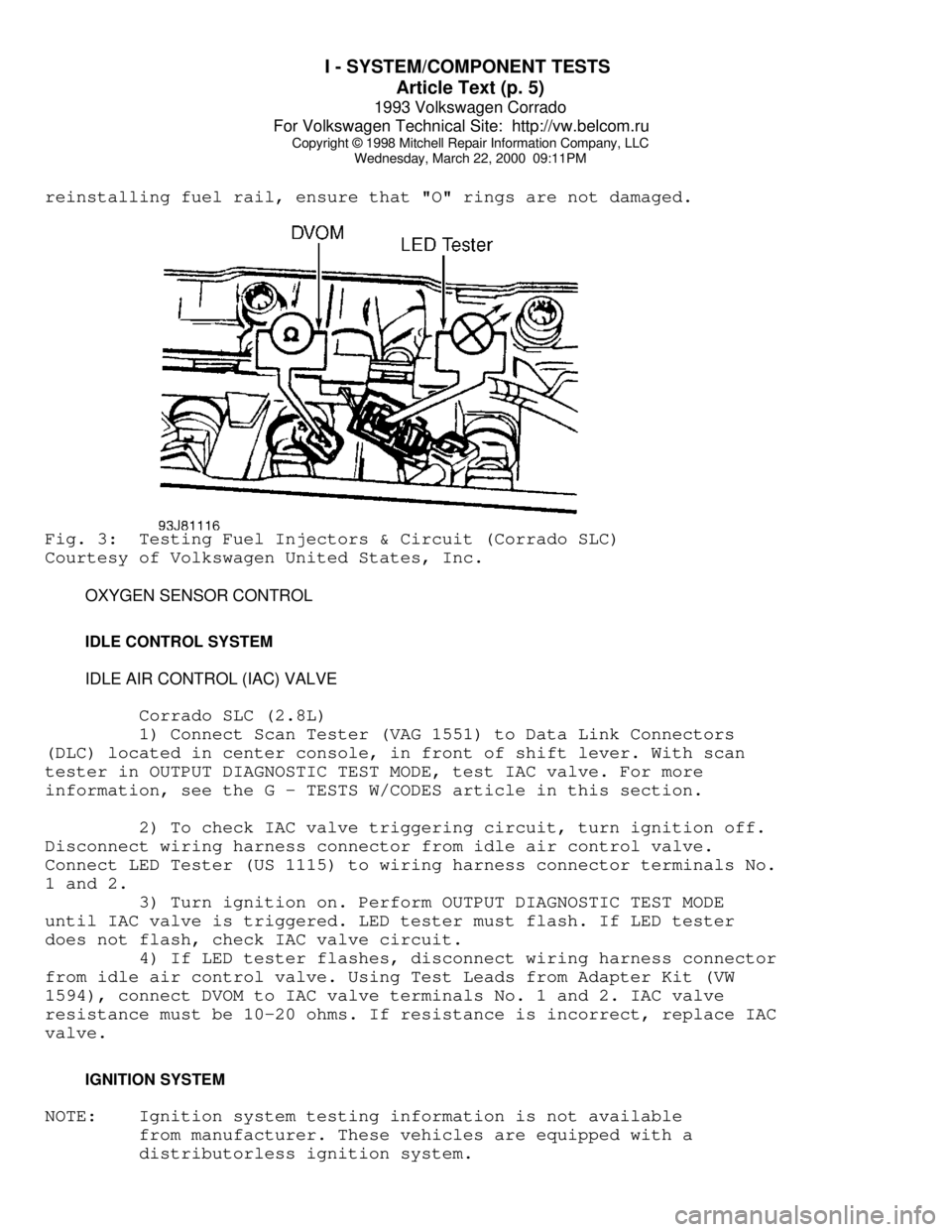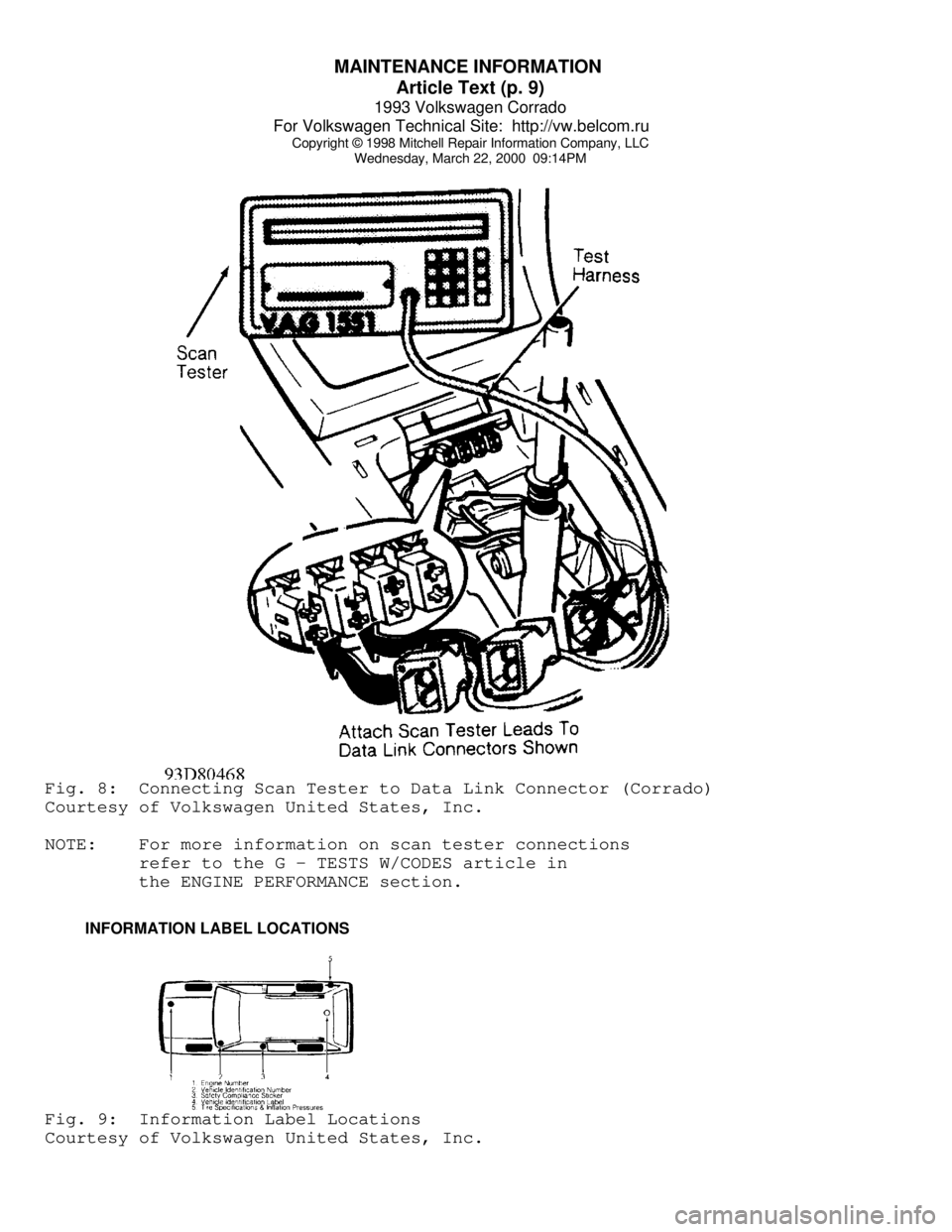1993 VOLKSWAGEN CORRADO technical data
[x] Cancel search: technical dataPage 614 of 920

I - SYSTEM/COMPONENT TESTS
Article Text (p. 2)
1993 Volkswagen Corrado
For Volkswagen Technical Site: http://vw.belcom.ru
Copyright © 1998 Mitchell Repair Information Company, LLC
Wednesday, March 22, 2000 09:11PM
COMPUTERIZED ENGINE CONTROLS
ELECTRONIC CONTROL MODULE (ECM)
Ground & Power Circuits
Check ECM ground and power circuits using the values in the
appropriate J - PIN VOLTAGE CHARTS article.
ENGINE SENSORS & SWITCHES
ENGINE COOLANT TEMPERATURE SENSOR
Corrado SLC (2.8L)
1) Ensure engine is cold. Connect Scan Tester (VAG 1551) to
Data Link Connectors (DLC) located in center console, in front of
shift lever. Start engine and allow it to idle.
2) With scan tester in READ TEST VALUE BLOCK function, select
group No. 01 and read coolant temperature value in field No. 2 of scan
tester. Temperature value must increase uniformly without
interruption. If value increases as specified, select END OUTPUT
function on scan tester.
3) If displayed value does not change or if engine
malfunctions during certain temperature ranges, turn ignition off and
measure engine coolant temperature sensor resistance. See ENGINE
COOLANT TEMPERATURE SENSOR RESISTANCE table.
ENGINE COOLANT TEMPERATURE SENSOR RESISTANCEÄÄÄÄÄÄÄÄÄÄÄÄÄÄÄÄÄÄÄÄÄÄÄÄÄÄÄÄÄÄÄÄÄÄÄÄÄÄÄÄÄÄÄÄÄTemperature
øF (øC) Ohms
68 (20) ......................... 3000-2000
86 (30) ......................... 2000-1500
104 (40) ........................ 1500-1000
122 (50) ......................... 1000-800
140 (60) .......................... 700-500
158 (70) .......................... 500-375
176 (80) .......................... 375-275
194 (90) .......................... 275-225
ÄÄÄÄÄÄÄÄÄÄÄÄÄÄÄÄÄÄÄÄÄÄÄÄÄÄÄÄÄÄÄÄÄÄÄÄÄÄÄÄÄÄÄÄÄ INTAKE AIR TEMPERATURE SENSOR
Corrado SLC (2.8L)
1) Turn ignition off. Disconnect intake air temperature
sensor. Remove sensor from intake manifold and plug opening in
manifold. Reconnect sensor to wiring harness.
2) Connect Scan Tester (VAG 1551) to Data Link Connectors
(DLC) located in center console, in front of shift lever. Start engine
and allow it to idle. With scan tester in READ TEST VALUE BLOCK
function, select group 03 and read intake air temperature sensor value
in field No. 4 of scan tester.
3) Spray sensor with cooling spray and observe value on scan
Page 615 of 920

I - SYSTEM/COMPONENT TESTS
Article Text (p. 3)
1993 Volkswagen Corrado
For Volkswagen Technical Site: http://vw.belcom.ru
Copyright © 1998 Mitchell Repair Information Company, LLC
Wednesday, March 22, 2000 09:11PM
tester. Scan tester value must decrease. If temperature value does not
change, repair intake air temperature sensor circuit or replace sensor
as necessary. After repairs, erase Diagnostic Trouble Code (DTC)
memory (if applicable) and select END OUTPUT function.
HALL EFFECT SENSOR
Corrado SLC (2.8L)
Testing information is not available from manufacturer. These
vehicles are equipped with a distributorless ignition system.
FUEL SYSTEM
ACCELERATION/FULL THROTTLE ENRICHMENT & DECELERATION FUEL
CUT-OFF
Corrado SLC (2.8L)
1) Ensure engine coolant temperature is at least 176øF
(80
øC). Connect Scan Tester (VAG 1551) to Data Link Connectors (DLC)
located in center console, in front of shift lever.
2) Start engine and allow it to idle. With scan tester in
READ TEST VALUE BLOCK function, select group No. 04 and read value in
field No. 4 of scan tester. Display value must be 00010 at idle.
3) Using accelerator pedal, increase engine speed to 3000 RPM
and observe scan tester. Display value in field No. 4 of scan tester
must briefly be 10100. Release accelerator pedal and observe scan
tester.
4) Display value in field No. 4 of scan tester must briefly
be 00011, then return to 00010 at idle. If values are not as
specified, see THROTTLE POSITION (TP) SENSOR ADJUSTMENT procedures in
the D - ADJUSTMENTS article. If values are as specified, select END
OUTPUT function on scan tester.
FUEL INJECTORS & CIRCUIT
Corrado SLC (2.8L)
1) To access fuel injectors, remove ignition wires. Remove
hose from mass airflow sensor. Disconnect hose to fuel evaporative
(frequency) solenoid valve at throttle body.
2) Disconnect throttle position sensor and idle air control
valve. Disconnect accelerator cable from throttle body. Disconnect and
plug coolant hoses at throttle body.
3) Disconnect hose from air intake heated tube. Detach fuel
lines at cylinder head cover and remove from fuel rail. Disconnect
vacuum hose from fuel pressure regulator. Remove intake manifold upper
section. See Fig. 2.
4) With intake manifold upper section removed, disconnect
wiring harness from fuel injectors. Using a Digital Volt-Ohmmeter
(DVOM) and test leads from Adapter Kit (VW 1594), check fuel injector
resistance. See Fig. 3.
5) Fuel injector resistance should be 15.0-21.5 ohms. If
resistance is zero ohms, check for a short circuit in wiring harness.
Page 617 of 920

I - SYSTEM/COMPONENT TESTS
Article Text (p. 5)
1993 Volkswagen Corrado
For Volkswagen Technical Site: http://vw.belcom.ru
Copyright © 1998 Mitchell Repair Information Company, LLC
Wednesday, March 22, 2000 09:11PM
reinstalling fuel rail, ensure that "O" rings are not damaged.Fig. 3: Testing Fuel Injectors & Circuit (Corrado SLC)
Courtesy of Volkswagen United States, Inc.
OXYGEN SENSOR CONTROL
IDLE CONTROL SYSTEM
IDLE AIR CONTROL (IAC) VALVE
Corrado SLC (2.8L)
1) Connect Scan Tester (VAG 1551) to Data Link Connectors
(DLC) located in center console, in front of shift lever. With scan
tester in OUTPUT DIAGNOSTIC TEST MODE, test IAC valve. For more
information, see the G - TESTS W/CODES article in this section.
2) To check IAC valve triggering circuit, turn ignition off.
Disconnect wiring harness connector from idle air control valve.
Connect LED Tester (US 1115) to wiring harness connector terminals No.
1 and 2.
3) Turn ignition on. Perform OUTPUT DIAGNOSTIC TEST MODE
until IAC valve is triggered. LED tester must flash. If LED tester
does not flash, check IAC valve circuit.
4) If LED tester flashes, disconnect wiring harness connector
from idle air control valve. Using Test Leads from Adapter Kit (VW
1594), connect DVOM to IAC valve terminals No. 1 and 2. IAC valve
resistance must be 10-20 ohms. If resistance is incorrect, replace IAC
valve.
IGNITION SYSTEM
NOTE: Ignition system testing information is not available
from manufacturer. These vehicles are equipped with a
distributorless ignition system.
Page 633 of 920

J - PIN VOLTAGE CHARTS
Article Text (p. 4)
1993 Volkswagen Corrado
For Volkswagen Technical Site: http://vw.belcom.ru
Copyright © 1998 Mitchell Repair Information Company, LLC
Wednesday, March 22, 2000 09:14PM
Connector & Jumper
Terminals No 1 & 2. ... 1.5 Ohms Max.
EGR Temperature
Sensor (15 & 33) ....... Disconnect Sensor
Connector & Jumper
Terminals No 1 & 2. ... 1.5 Ohms Max.
(1) - TESTING CONDITIONS: Disconnect harness connector from ECM.
Connect Test Box (VAG 1598/18) to ECM harness connector, leaving
the ECM disconnected.
(2) - With ignition off, jumper terminals No. 9 and No. 55 of the
test box.
(3) - Refer to the I - SYS/COMP TESTS article.
(4) - These are terminal connectors at data link connector.
(5) - 3-pin connector is located at rear of engine mount.
(6) - 3-pin Black connector is located next to starter.
(7) - 3-pin White connector is located next to starter.ÄÄÄÄÄÄÄÄÄÄÄÄÄÄÄÄÄÄÄÄÄÄÄÄÄÄÄÄÄÄÄÄÄÄÄÄÄÄÄÄÄÄÄÄÄÄÄÄÄÄÄÄÄÄÄÄÄÄÄÄÄÄÄÄÄÄÄÄÄÄEND OF ARTICLE
Page 656 of 920

MAINTENANCE INFORMATION
Article Text (p. 9)
1993 Volkswagen Corrado
For Volkswagen Technical Site: http://vw.belcom.ru
Copyright © 1998 Mitchell Repair Information Company, LLC
Wednesday, March 22, 2000 09:14PMFig. 8: Connecting Scan Tester to Data Link Connector (Corrado)
Courtesy of Volkswagen United States, Inc.
NOTE: For more information on scan tester connections
refer to the G - TESTS W/CODES article in
the ENGINE PERFORMANCE section.
INFORMATION LABEL LOCATIONSFig. 9: Information Label Locations
Courtesy of Volkswagen United States, Inc.
Page 658 of 920

MAINTENANCE INFORMATION
Article Text (p. 11)
1993 Volkswagen Corrado
For Volkswagen Technical Site: http://vw.belcom.ru
Copyright © 1998 Mitchell Repair Information Company, LLC
Wednesday, March 22, 2000 09:14PM
Application Quantity (1)
A/C System R-12 Refrigerant
1990-92 (up to 7/92) ............................. 37-40 Ozs.
A/C System R-134a Refrigerant (2)
1993-94 (from 7/92) ........................... 28.2-31.8 Ozs.
Cooling System
4-Cyl. ...................................... 6.8 Qts. (6.5L)
V6 .......................................... 9.1 Qts. (8.6L)
Engine Oil (3)
4-Cyl. ...................................... 4.3 Qts. (4.0L)
V6 .......................................... 6.3 Qts. (6.0L)
Fuel Tank
4-Cyl. ..................................... 14.5 Gals. (55L)
V6 ......................................... 18.5 Gals. (55L)
Automatic Transmission
Fluid Change ................................ 3.2 Qts. (3.0L)
Overhaul .................................... 5.9 Qts. (5.6L)
Manual Transmission ........................... 2.1 Qts. (2.0L)
Final Drive
Differential (A/T) (4) ....................... 0.8 Qt. (.75L)
(1) - Capacities are recommended or calculated levels. Always use
dipstick (if available) to measure level.
(2) - Use of R-12 in a R134a system will result in SEVERE DAMAGE.
(3) - Includes oil filter change.
(4) - Lifetime fill.ÄÄÄÄÄÄÄÄÄÄÄÄÄÄÄÄÄÄÄÄÄÄÄÄÄÄÄÄÄÄÄÄÄÄÄÄÄÄÄÄÄÄÄÄÄÄÄÄÄÄÄÄÄÄÄÄÄÄÄÄÄÄÄÄÄ WHEEL & TIRE SPECIFICATIONS
Wheel and tire sizes vary according to vehicle and equipment
and can be found on tire information label on each vehicle. Wheel and
tire specifications and tire inflation pressures are listed on a label
found inside fuel tank flap.
NOTE: Snow chains must be used on drive wheels, in pairs only.
WHEEL TIGHTENING
Tighten all wheel lugs to 80 ft. lbs. (110 N.m).
BATTERY SPECIFICATIONS
CAUTION: When battery is disconnected, vehicles equipped with
computers may lose memory data. When battery power is
restored, driveability problems may exist on some vehicles.
These vehicles may require a relearn procedure. See COMPUTER
RELEARN PROCEDURES article in the GENERAL INFORMATION
section.
All models use BCI group 41 batteries with cold crank rating
Page 678 of 920

N - REMOVE/INSTALL/OVERHAUL
Article Text
1993 Volkswagen Corrado
For Volkswagen Technical Site: http://vw.belcom.ru
Copyright © 1998 Mitchell Repair Information Company, LLC
Wednesday, March 22, 2000 09:21PM
ARTICLE BEGINNING
1993 ENGINE PERFORMANCE
Removal, Overhaul & Installation
Corrado SLC
CAUTION: When battery is disconnected, vehicle computer and memory
systems may lose memory data. Driveability problems may
exist until computer systems have completed a relearn
cycle. See the COMPUTER RELEARN PROCEDURES article in
GENERAL INFORMATION before disconnecting battery.
INTRODUCTION
Removal, overhaul and installation procedures are covered in
this article. If component removal and installation is primarily an
unbolt and bolt-on procedure, only a torque specification may be
furnished.
CAUTION: When disconnecting battery, obtain and record radio
anti-theft code. If wrong code is entered into radio after
power is restored, radio will become inoperable.
IGNITION SYSTEM
NOTE: Corrado SLC ignition system removal and installation
information not available from manufacturer. These vehicles
are equipped with a distributorless ignition system.
DISTRIBUTOR
FUEL SYSTEM
FUEL SYSTEM PRESSURE RELEASE
To relieve fuel system pressure, remove fuel pump fuse (No.
5, 13 or 18) or fuel pump relay to deactivate fuel pump. Place a clean
shop rag around fuel line fitting and slowly loosen fitting.
WARNING: Fuel system pressure release procedure is not available
from manufacturer. Fuel will discharge when disconnecting
fuel system components. Disconnect ignition coil output
stage wiring harness to deactivate ignition. DO NOT smoke
or work near heaters or other fire hazards. Keep a fire
extinguisher handy.
FUEL PUMP
Removal & Installation (Corrado SLC)
1) Obtain and record radio anti-theft code. Disconnect
Page 684 of 920

SCHEDULED SERVICES
Article Text (p. 2)
1993 Volkswagen Corrado
For Volkswagen Technical Site: http://vw.belcom.ru
Copyright © 1998 Mitchell Repair Information Company, LLC
Wednesday, March 22, 2000 09:22PM
SUPPLEMENTAL RESTRAINT SYSTEM (SRS) AIR BAR WARNING
NOTE: For information on air bag DIAGNOSIS & TESTING or DISPOSAL
PROCEDURES, see AIR BAGS article in the ACCESSORIES/SAFETY
EQUIPMENT Section.
System circuit is grounded by 2 screws beneath the driver's
seat. DO NOT use these screws to ground any other accessory. DO NOT
ground any other components near this system.
AIR CONDITIONING SERVICING (1993 & LATER)
CAUTION: Avoid breathing R-134a refrigerant and PAG lubricant vapors,
exposure may irritate eyes, nose and throat. To remove
R-134a from system use R-134a recycling equipment that meets
SAE J2210 specifications. If accidental system discharge
occurs, ventilate work area before resuming service.
WARNING: R-134a service equipment or vehicle A/C systems SHOULD NOT
be pressure tested or leak tested with compressed air. Some
mixtures of air/R134a have shown to be combustible at
elevated pressures. These mixtures are dangerous and may
cause fire and/or explosions. See AIR CONDITIONING SERVICE
article in GENERAL INFORMATION section.
ANTI-LOCK BRAKE SYSTEM
The anti-lock brake system contains electronic equipment that
can be susceptible to interference caused by improperly installed or
high output radio transmitting equipment. Since this interference
could cause the possible loss of the anti-lock braking capability,
such equipment should be installed by qualified professionals.
On models equipped with anti-lock brake systems, ALWAYS
observe the following cautions:
* DO NOT attempt to bleed hydraulic system without first
referring to the appropriate ANTI-LOCK BRAKE SYSTEM article
in the BRAKES Section.
* DO NOT mix tire sizes. As long as tires remain close to the
original diameter, increasing the width is acceptable.
Rolling diameter must be identical for all 4 tires. Some
manufacturers recommend tires of the same brand, style and
type. Failure to follow this precaution may cause inaccurate
wheel speed readings.
* Use ONLY recommended brake fluids. DO NOT use silicone brake
fluids in an ABS-equipped vehicle.
BATTERY WARNING
WARNING: When battery is disconnected, vehicles equipped with
computers may lose memory data. When battery power is